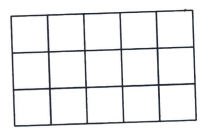Singapore Math Olympiad Past years Questions- Combinatorics (Senior)
 Join Trial or Access Free Resources
Join Trial or Access Free Resources Join Trial or Access Free Resources
Join Trial or Access Free ResourcesFind the number of possible ways of arranging \(m\) ones and \(n\) zeros in a row such that there are in total \(2 k+1\) strings of ones and zeros. For example, \(1110001001110001\) consists of 4 strings of ones and 3 strings of zeros.
The following \(3 \times 5\) rectangle consists of \(151 \times 1\) squares. Determine the number of ways in which 9 out of the 15 squares are to be coloured in black such that every row and every column has an odd number of black squares.

There are 6 couples, each comprising a husband and a wife. Find the number of ways to divide the 6 couples into 3 teams such that each team has exactly 4 members, and that the husband and the wife from the same couple are in different teams.
Eleven distinct chemicals \(C_1, C_2, \ldots, C_{11}\) are to be stored in three different warehouses. Each warehouse stores at least one chemical. A pair \(C_i, C_j\) of chemicals, where \(i \neq j\), is either compatible or incompatible. Any two incompatible chemicals cannot be stored in the same warehouse. However, a pair of compatible chemicals may or may not be stored in the same warehouse. Find the maximum possible number of pairs of incompatible chemicals that can be found among the stored chemicals.
Some students sat for a test. The first group of students scored an average of 91 marks and were given Grade A. The second group of students scored an average of 80 marks and were given Grade B. The last group of students scored an average of 70 marks and were given Grade \(\mathrm{C}\). The numbers of students in all three groups are prime numbers and the total score of all the students is 1785 . Determine the total number of students.